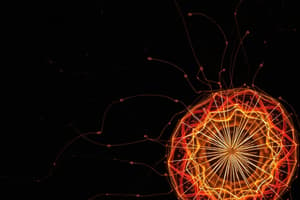Podcast
Questions and Answers
What is the structural composition of centrioles and their role during cell division?
What is the structural composition of centrioles and their role during cell division?
Centrioles consist of nine triplets of microtubules and play a crucial role by duplicating and facilitating the formation of the spindle apparatus during cell division.
Describe the three types of cytoskeletal fibers and their importance in cellular function.
Describe the three types of cytoskeletal fibers and their importance in cellular function.
The three types of cytoskeletal fibers are microtubules, microfilaments, and intermediate filaments, which collectively provide structure, facilitate movement, and regulate cell shape.
Explain the composition and function of microtubules within the cell.
Explain the composition and function of microtubules within the cell.
Microtubules are made up of tubulin protein and function to form spindle fibers as well as cilia and flagella, aiding in cell division and motility.
What are microfilaments, and how do they contribute to cytoplasmic movements?
What are microfilaments, and how do they contribute to cytoplasmic movements?
Discuss the role of intermediate filaments in maintaining cell structure.
Discuss the role of intermediate filaments in maintaining cell structure.
How do microtubules relate to the formation of cilia and flagella?
How do microtubules relate to the formation of cilia and flagella?
What types of proteins predominantly make up microfilaments, and what is their primary function?
What types of proteins predominantly make up microfilaments, and what is their primary function?
Flashcards are hidden until you start studying
Study Notes
Centrioles
- Composed of nine triplets of microtubules, centrioles play a crucial role during cell division.
- At cell division onset, centrioles duplicate, forming two pairs that migrate to opposite poles, assisting in spindle apparatus formation.
- Also involved in the development of cilia and flagella, enabling cellular movement and function.
Cytoskeleton
- The cytoskeleton is a complex network of fibrous proteins dispersed throughout the cytoplasm.
- It consists of three primary types of fibers: microtubules, microfilaments, and intermediate filaments, each serving distinct structural and functional roles.
Microtubules
- Made of tubulin protein, microtubules are rigid, unbranched hollow structures.
- Serve as the foundation for spindle fibers, as well as the structural components of cilia and flagella, facilitating cell motility and division.
Microfilaments
- Comprising thin protein fibers primarily composed of actin, microfilaments are essential for cellular movements.
- Responsible for the streaming motions within the cytoplasm, they contribute to various cellular processes such as shape maintenance and motility.
Intermediate Filaments
- Intermediate filaments consist of various proteins like keratin and vimentin, forming a supportive branching network.
- They maintain cell structure and stability, and in tissues, they facilitate the anchoring of cells to one another, ensuring tissue integrity.
Studying That Suits You
Use AI to generate personalized quizzes and flashcards to suit your learning preferences.



